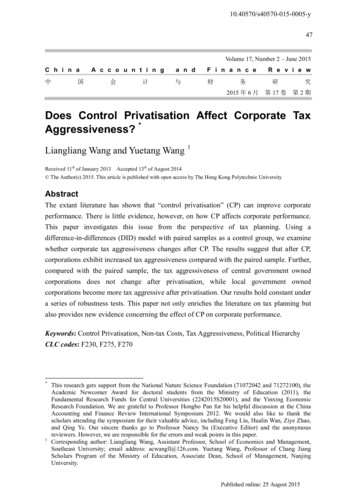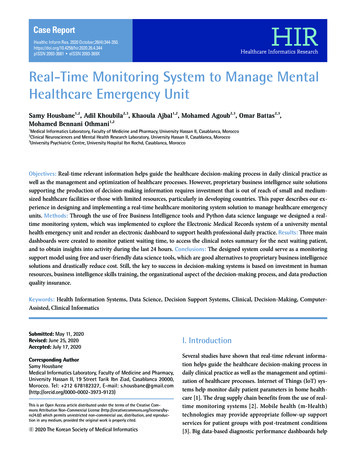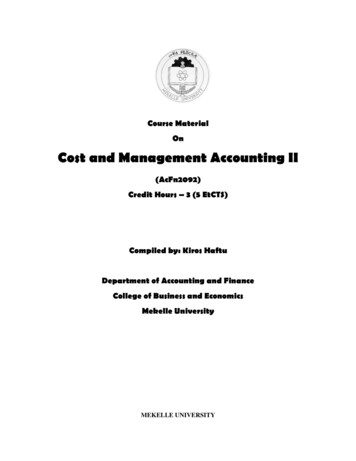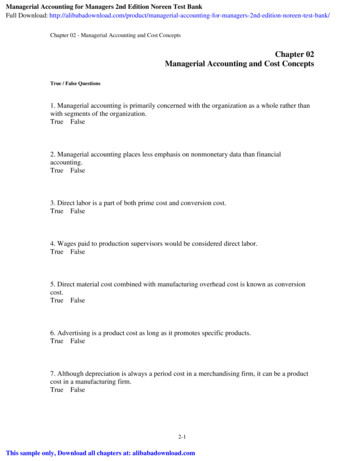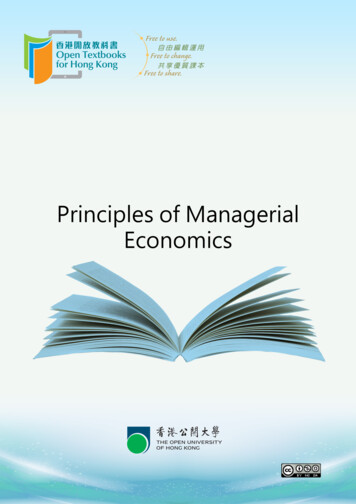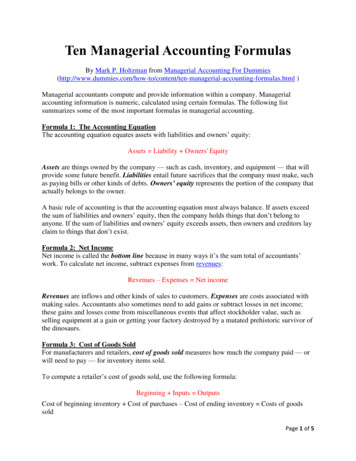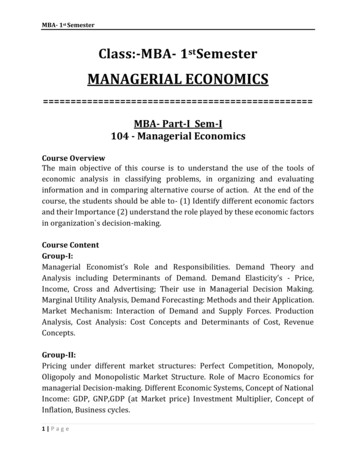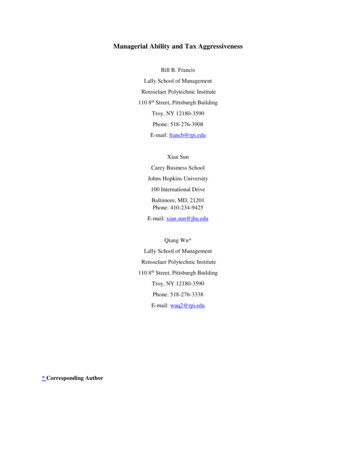
Transcription
Managerial Ability and Tax AggressivenessBill B. FrancisLally School of ManagementRensselaer Polytechnic Institute110 8th Street, Pittsburgh BuildingTroy, NY 12180-3590Phone: 518-276-3908E-mail: francb@rpi.eduXian SunCarey Business SchoolJohns Hopkins University100 International DriveBaltimore, MD, 21201Phone: 410-234-9425E-mail: xian.sun@jhu.eduQiang Wu*Lally School of ManagementRensselaer Polytechnic Institute110 8th Street, Pittsburgh BuildingTroy, NY 12180-3590Phone: 518-276-3338E-mail: wuq2@rpi.edu* Corresponding Author
Managerial Ability and Tax AggressivenessAbstract: We find a negative relationship between managerial ability and tax aggressiveness. Theresult is robust to a wide range of measures of tax aggressiveness, inclusion of firm fixed effects,and the use of a difference-in-differences method to control for endogeneity. Further tests showthat this negative relationship is more pronounced for firms with higher investment opportunitiesor firms with more reputational concerns. Given the significant costs associated with taxaggressiveness and the negative effect it can have on managerial reputation if discovered, ourresults suggest that more able managers invest less effort in aggressive tax avoidance activities.Keywords: Managerial ability; Tax aggressivenessJEL classification: H26; M41; M122
1. IntroductionThe last two decades have witnessed steady increases in tax avoidance in corporate America.Accordingly, corporate tax avoidance has received considerable attention from both academicsand policy makers. Hanlon and Heitzman (2010, p. 137) note that “clearly, most interest, both forresearchers and for tax policy, is in actions at the aggressive end of the (tax avoidance)continuum.”1 An emerging literature examines the determinants of aggressive tax avoidance (e.g.,Armstrong et al., 2012; Rego and Wilson, 2012; Chyz et al., 2013; Hoi et al., 2013; McGuire etal., 2014). However, most studies focus on firm-level characteristics or corporate governancemechanisms and largely ignore how individual managers impact corporate tax aggressiveness (Chiet al., 2017), despite the fact that corporate decisions are made by individual persons and individualmanager “styles” play a significant role in making strategic and operational decisions (Bertrandand Schoar, 2003).2Dyreng et al. (2010) make an important step in this research area and find that managerialfixed effects are important determinants of firms’ tax avoidance. They further find that commonindividual characteristics such as education, gender, and age cannot explain this variation, althoughthey conclude that “the executive effects on tax avoidance appear to be idiosyncratic” (p. 1165).Managerial ability, which captures the dimension of managerial human capital, is exceptionallyimportant for the success of corporations (Francis et al., 2008; Shavinina and Medvid, 2009). Priorstudies show that managerial ability has a significant impact on various corporate decisions,Hanlon and Heitzman (2010, p. 137) define tax avoidance as the “reduction of explicit taxes” and state that “if taxavoidance represents a continuum of tax planning strategies where something like municipal bond investments are atone end, then terms such as ‘noncompliance,’ ‘evasion,’ ‘aggressiveness,’ and ‘sheltering’ would be closer to the otherend of the continuum.” We use tax aggressiveness and aggressive tax avoidance interchangeable in this paper.12One exception is Chyz (2013), who finds that managers who are more likely to avoid personal taxes are also morelikely to avoid corporate taxes.1
including investment and accounting decisions (e.g., Rose and Shepard, 1997; Bertrand and Schoar,2003; Demerjian et al., 2013). Thus, individual managerial abilities might provide a plausibleexplanation for why managers matter for corporate tax aggressiveness and could help move theliterature forward.It can be argued that a more able manager who is better at generating economic benefitsfrom normal operations should also be more successful at exploiting all tax avoidanceopportunities including aggressive tax strategies. However, this argument ignores severalimportant factors that could lead to an opposite prediction.First, although traditional theory views tax avoidance as a value-added activity thattransfers wealth from the government to shareholders, more recent studies find that tax avoidanceactivities, especially aggressive tax avoidance activities, result in significant direct costs (e.g., costsinvolving tax planning, litigation, and penalties) and indirect costs (e.g., agency, reputational, andcapital costs) (e.g., Bankman, 2004; Desai and Dharmapala, 2009; Hanlon and Slemrod, 2009;Hasan et al., 2014).3 For example, Wilson (2009) finds that the direct costs alone could potentiallyoffset the tax savings from aggressive tax avoidance. Hutchens and Rego (2012) find that highertax reserves are associated with a higher cost of capital and Hasan et al. (2004) document a positiverelation between tax avoidance and the cost of debt. Hanlon and Slemrod (2009) find a negativestock market reaction to news reporting company involvement in tax shelters, suggesting investorsview tax aggressiveness negatively and require a higher rate of return for the risky tax position.3For example, in 2014, the Internal Revenue Service (IRS) issued enforcement actions against Microsoft and itsformer executives related to the transfer prices for patents that Microsoft charged to its subsidiary in Puerto Rico. InJuly 2016, the IRS delivered a notice of deficiency to Facebook for 3 billion to 5 billion, plus interest and penalties,based on the agency’s audit of Facebook’s transfer pricing for intellectual property to Ireland.2
Second, managerial ability is closely related to managerial reputation (e.g., Fee andHadlock, 2003; Francis et al., 2008) and media coverage (e.g., Milbourn, 2003; Rajgopal et al.,2006). The tax literature suggests that reputational concerns limit firms’ and managers’ willingnessto engage in aggressive tax avoidance (e.g., Desai and Dharmapala, 2006, Hanlon and Slemrod,2009, Chen et. al., 2012, Graham et al., 2014). For example, in responding to the survey by Grahamet al. (2014), 72% (60%) of publicly traded firms’ top executives agree that “potential harm totheir firms’ reputations” (“adverse media attention”) is an important factor to consider whendeciding which tax planning strategies to implement. Empirically, Dyreng et al. (2016) find publicpressure plays a significant role in deterring public firms’ aggressive tax avoidance. Chyz andGaertner (2017) provide evidence that CEOs are more likely to experience forced turnover whentheir firms’ effective tax rates are much lower than benchmark. Anecdotal evidence also indicatesthat managers suffer from loss of reputation and adverse media attention as a result of aggressivetax avoidance activities. For example, GE’s former CEO, Jeffrey R. Immelt, has received a lot ofcriticisms from the media and the public since the revelation of GE’s aggressive tax avoidancefirst surfaced in the New York Times in 2011.Hirshleifer (1993) points out that those managers who possess higher abilities areconcerned with maintaining their reputation when making corporate decisions. Economic theoryalso suggests that managers with significant reputation at stake will not, because of career concerns,indulge in opportunistic rent-seeking behavior (Fama, 1980).4 Thus, given the negative impact thatloss of reputation can have on a manager’s career, we expect that managers with higher abilities4Desai and Dharmapala (2006) and Kim et al. (2011) argue that managers can use complex and obfuscated taxavoidance activities to mask and facilitate rent extraction and other self-serving actions, potentially leading to greatermanagerial opportunism.3
who clearly have greater employment opportunities and thus, more to lose, will have less incentiveto engage in aggressive tax avoidance activities.Third, Hanlon and Heitzman (2010) and Armstrong et al. (2015) point out that tax planningis an investment decision like any other investment opportunities. Managers’ decisions regardingtax aggressiveness are determined not only by whether tax aggressiveness has positive net presentvalue (NPV), but also by how the NPV of tax aggressiveness against the NPV of other investmentoptions. Financial theory tells us that rational managers should devote greater resources and effortsto projects that offer the highest positive NPV (Simon, 1973). If a superior manager could achievehigher increases in shareholder value through normal investment options, the NPV of normalinvestments would be relatively higher than the NPV of tax aggressiveness. Consequently,managers with higher abilities should have more incentive to invest in normal investment optionsand less incentive to engage in aggressive tax avoidance activities. This argument is consistentwith the survey evidence in Graham et al. (2014) showing that managers rank “lacking businesspurpose and/or economic substance” as the most important reason for not implementing a taxstrategy.Demerjian et al. (2012) quantifies managerial ability by calculating how efficientlymanagers generate revenues from given economic resources using the data envelopment analysis(DEA) approach. Their study provides a comprehensive validity test that demonstrates that theirmethod of measuring managerial ability is superior to other measures (e.g., abnormal returns,performance, tenure, and media coverage) with respect to capturing individual talent. Other studies(e.g., Baik et al., 2011; Demerjian et al., 2013) use this measure and find that managerial ability ispositively related to earnings quality, management earnings forecast, and firm performance. Givenits superior power to capture managerial ability regarding normal operational efficiency,4
Dermerjian et al.’s (2012) score is well suited for our empirical analyses given the underlyingtheoretical framework of our paper.Because we are interested in the aggressive end of tax avoidance, following prior studies(e.g., Wilson, 2009; Rego and Wilson, 2012; Kim and Zhang, 2016), we use tax shelter probability,predicted unrecognized tax benefits (UTB), and the bottom quintile of industry and year adjustedcash effective tax rate (CETR) as our primary measures of tax aggressiveness. To mitigate thereverse causality concern, following prior studies such as Dermerjian et al. (2013) and Hoi et al.(2013), we measure managerial ability one year prior to our tax aggressiveness proxies. Using asample of 42,329 firm-year observations for 7,001 US firms from 1988 through 2009, we find anegative and significant relationship between managerial ability and tax aggressiveness aftercontrolling for firm-level factors that have been shown to impact tax aggressiveness, indicatingthat more able managers are less likely to engage in aggressive tax avoidance. Our results arerobust to the use of alternative measures of tax aggressiveness and managerial ability. Our resultsare also robust to using firm fixed effects regressions to address omitted variable bias and to usingtwo- or three-year lags with managerial ability to further mitigate concerns about reverse causality.To further mitigate endogeneity concerns, we employ a difference-in-differences approachusing information regarding CEO turnover. Specifically, we identify a treatment sample of firmsthat were managed by low-ability CEOs prior to the turnover but came under the management ofhigh-ability CEOs subsequent to such turnover. We also construct a control sample of firms thatwere managed by low-ability CEOs and remained that way following CEO turnover. Thedifference-in-differences results indicate that a low-to-high managerial ability switch leads to asignificant reduction in the level of tax aggressiveness compared to a low-to-low managerial abilityswitch.5
In this paper, we argue that higher ability managers are associated with fewer aggressivetax avoidance activities because they can turn resources into economic benefits more efficientlythrough normal operations and therefore have less incentive to engage in aggressiveness taxavoidance activities. To the extent that this is the case, we should observe that the negativerelationship between managerial ability and tax aggressiveness is more significant when a firm hashigher investment opportunities. To test this conjecture, we interact managerial ability and proxiesof investment opportunities (i.e., firms with higher capital expenditures or firms with highermarket-to-book (M/B) ratios) and re-estimate our regressions. We find that the identifiedrelationship is significantly stronger for firms with higher investment opportunities. This findingprovides support for our conjecture that normal investment opportunities provide a plausiblechannel through which managerial ability affects tax aggressiveness.In this paper, we also argue that managers with higher abilities have higher reputation andmore opportunities in the managerial labor markets. As such, they will be less likely to engage inaggressive tax avoidance activities given the significant negative impact it could have on theirreputation and hence their career possibilities if discovered. We test this conjecture by interactingmanagerial ability and managerial reputational pressure as measured by whether a firm is an S&P1, 500 firm (Denis et al., 2003) or a firm is covered by more financial analysts (Allan et al., 2016).We find evidence that the negative relation between managerial ability and tax aggressiveness ismore pronounced for firms with higher reputational pressure, which indicates that managerialreputational concerns could be another channel through which managerial ability affects taxaggressiveness negatively.Our paper contributes to the growing literature on the determinants of corporate taxaggressiveness. Our findings advance the understanding of the “under-sheltering puzzle”, which6
questions why some firms actively engage in aggressive tax avoidance activities whereas othersdo not (Weisbach, 2002), and which, according to Gallemore et al. (2014), “is very much an openquestion in the literature.” We contend that it is important that firms’ aggressive tax planning isviewed as investment decisions with significant costs, which are less attractive options formanagers who have greater abilities to realize higher increases in shareholder value throughnormal investments. Our finding supports this conjecture, and it provides a reasonable explanationfor why some firms voluntarily forgo tax aggressiveness opportunities. Furthermore, our paperextends Dyreng et al. (2010) by providing a plausible explanation for the relationship betweenmanagerial fixed effects and firm tax decisions. Our finding, which sheds light on this relationship,moves the literature forward.Our paper also contributes to the growing research on the attributes of managers,particularly managerial ability. Managerial ability has been an important topic of extensiveresearch in the economic and management literatures (e.g., Rose and Shepard, 1997; Shavininaand Medvid, 2009). More recent studies introduce this topic into finance and accounting researchand find that managerial ability is an important factor that affects firm performance and corporateaccounting decisions, including earnings quality and management earnings forecasts (Baik et al.,2011; Demerjian et al., 2012, 2013). Our study finds that managerial ability also significantlyaffects corporate tax decisions. Additionally, our findings have important public policyimplications for regulators, investors, and managerial labor markets.The rest of the paper proceeds as follows. Section 2 reviews the related literature anddevelops our theoretical framework. Section 3 describes the data and methodology. Section 4presents the results on the relationship between managerial ability and tax avoidance. Section 57
explores possible channels for this relationship. Section 6 provides additional tests, includingalternative measures of managerial ability and tax avoidance. Section 7 concludes.2. Literature review and Theoretical frameworkThis section discusses related literature, highlights the incremental contribution, andformulates the hypothesis on the relationship between tax aggressiveness and managerial ability.2.1. Incremental contribution in relation to contemporary studiesA contemporary work by Koester et al. (2016) examines the relation between managerialability and general tax avoidance. Koester et al. (2016) find there is a positive relation betweenconcurrent managerial ability and tax avoidance as measured by various forms of cash effectivetax rate. While Koester et al. (2016) focus on general tax avoidance, we aim at tax aggressiveness,which is a subset of tax avoidance, and its underlying positions likely have weak legal support(Lisowsky et al., 2013). Consequently, tax aggressiveness is more likely to be challenged by thetax authority and faces public scrutiny (Dyreng et al., 2016). Studies on tax aggressiveness aremore of the interest of academic, regulators, and policy makers (Hanlon and Heitzman, 2010).In fact, both findings in our paper and in Koester et al. (2016) are consistent with Chyz andGaertner (2017) and Armstrong et al. (2015). Chyz and Gaertner (2017) find a nonlinearrelationship between forced CEO turnover and firm’s tax avoidance activities. Specifically, theyshow that both CEOs engaging in excessive tax avoidance and too little tax avoidance are morelikely to experience forced turnover. Armstrong et al. (2015) show that good corporate governanceis positively (negatively) related to extremely low (high) levels of tax avoidance. On the one hand,high-ability managers might not forgo general tax avoidance opportunities if such investments are8
associated with less risk. On the other hand, when certain aggressive tax strategies are associatedwith high levels of risk, high-ability managers would have less incentive to take such investments.Empirically, Koester et al. (2016) use CETR as their primary measure of tax avoidancewhile we use tax shelter probability and predicted UTB as our primary measures of taxaggressiveness. In Figure 1 of Lisowsky et al. (2015, p.591), they depict various measures residealong the tax avoidance continuum that spans from perfectly legitimate positions on the left to theextremely uncertain positions on the right. According to Lisowsky et al. (2015), CETR is on thevery left of the continuum while tax sheltering and UTB are on the very right of the continuum.So our paper and Koester et al. (2016) examine different aspects of tax avoidance.Another major difference between our paper and Koester et al. (2016) is that, although bothof us use Demerjian et al. (2012) managerial ability measure, we use lagged managerial abilitymeasure while Koester et al. (2016) use contemporaneous managerial ability measure. When wetest the robustness of our results by using contemporaneous managerial ability, we continuouslyfind a negative relation between managerial ability and tax aggressiveness.We further reconcile Koester et al. (2016) and find their empirical analyses could be subjectto model misspecification issue and omitted variable bias. For example, when we includeadditional controls that are not in Koester et al. (2016) but in our model, some of their results lostsignificance. More importantly, when we control concurrent and lagged managerial abilitysimultaneously, their results become weaker or even disappeared. We also find that the joint effectbetween concurrent and lagged managerial ability is negative and significant, further confirmingan overall negative relation between managerial ability and tax aggressiveness.9
2.2. Theoretical frameworkThe literature on corporate tax avoidance, particularly the aggressive end of tax avoidance,is relatively young, and “the field cannot explain the variation very well” (Hanlon and Heitzman,2010, p.145). Recently, a growing number of studies have begun to examine this question (e.g.,Armstrong et al., 2012; Rego and Wilson, 2012; Chyz et al., 2013; Hoi et al., 2013; McGuire etal., 2014). However, most studies focus on firm-level characteristics or corporate governancemechanisms and largely ignore how individual managers impact corporate tax aggressiveness,despite the fact that corporate decisions are made by individual persons and individuals’ “styles”play a significant role in making strategic and operational decisions (Bertrand and Schoar, 2003).One exception in the literature is Dyreng et al. (2010), who focus on the individual impactof top managers. Examining a group of executives that switch firms, these authors find that the topmanagement team plays a significant role in determining firm tax avoidance activities that cannotbe explained by firm characteristics. Although this study is an important first step in examiningindividual managers’ effects on tax avoidance, the authors are not able to explain the variationamong managers’ individual effects in that they find that common observable characteristics suchas education, gender, and age are not associated with executives’ propensities to reduce taxes.Thus, Hanlon and Heitzman (2010) call for more research into how manager effects impactcorporate tax avoidance. Chyz (2013) make a nice move and find that managers who areaggressively avoid personal taxes are also more likely to engage in tax sheltering in the firms thatthey manage, suggesting that individual personal tax attitude affects his/her tax decisions of thefirms that they work at.We believe that studying the effects of managerial ability on firms’ tax aggressivenesscould help better understand how individual managers affect tax aggressiveness and advance the10
literature in this regard. As discussed above, managerial ability captures managerial human capital(Francis et al., 2008) and is “one of the most important intangible assets that a firm has” (GainesRoss, 2003). Prior studies find that managerial ability has significant impacts on corporate financeand investment policies that are crucial to the success of corporations (e.g., Rose and Shepard,1997; Bertrand and Schoar, 2003; Shavinina and Medvid, 2009). More recent studies introducemanagerial ability to the accounting and finance literature and find that managerial ability ispositively related to earnings quality (Demerjian et al., 2013), management earnings forecast (Baiket al., 2011), and firm performance (Demerjian et al., 2012).How does managerial ability affect corporate tax aggressiveness? At first glance, it mightbe argued that a more able manager who is better at normal operations should also be better atexploiting all possible tax avoidance opportunities including aggressive tax activities. However,this argument ignores several important factors which could lead to a prediction of a negativerelation between these two.First, Hanlon and Heitzman (2010) point out that tax aggressiveness should be viewed asan investment decision and that value-maximizing firms should invest in tax aggressiveness whenits marginal benefits exceed its marginal costs. However, whether the marginal benefits of taxaggressiveness exceed its marginal costs is uncertain. Second, managers with higher abilities areconcerned about their reputation in the capital and labor markets. It is possible that higher abilitymanagers have less incentive to engage in aggressive tax avoidance activities than lower abilitymanagers due to reputational concerns. Third, managers’ effort and time is limited (Simon, 1973).Rational managers should devote greater effort and time to projects that offer the highest positiveNPV. If a superior manager can increase shareholder value more through normal investments, theNPV of these normal investments would be relatively higher than the NPV of tax aggressiveness.11
Consequently, managers with higher abilities should have more incentive to invest in normaloperations and less incentive to engage in aggressive tax avoidance activities.Next, we continue the discussion of viewing tax aggressiveness as an investment decisionby reviewing the primary benefits and costs of tax aggressiveness and explaining in detail whymanagerial ability could have a negative impact on tax aggressiveness.The conjecture that tax aggressiveness provides direct benefits is based on the intuition thattax aggressiveness produces tax savings. For instance, at a statutory federal tax rate of 35%, thefirm’s tax bill could be up to one-third of its pre-tax profits. Thus, the potential tax savings fromaggressiveness strategies might be economically large. For example, Dyreng et al. (2013) find thatthe use of Delaware subsidies as domestic tax havens, on average, increases net income by 1 1.5%.However, an increasing number of recent studies find that tax avoidance activities,especially aggressive tax avoidance activities, incur significant costs that are both direct andindirect. Direct costs include tax planning costs, litigation and other expenses of mounting adefense against challenges from the tax authorities, back taxes, potentially hefty penalties and finesimposed by the tax authorities, and more rigorous scrutiny from tax authorities in the long run (i.e.,being blacklisted by the IRS).Anecdotal evidence indicates that the direct costs can be substantial. For example,GlaxoSmithKline PLC settled with the IRS for 3.4 billion in connection with transfer pricingpractices that sought to avoid taxes (Wall Street Journal, 2006). AstraZeneca PLC paid 1.1 billionto settle a similar dispute with the IRS in 2011. Merck & Co. settled several disputed tax issuesincluding its use of minority equity interest financing transactions with the IRS in 2007 by payinga settlement of 2.3 billion, which included back taxes, penalties, and interest. In July 2016, theIRS delivered a notice of deficiency to Facebook for 3 billion to 5 billion, plus interest and12
penalties, based on the agency’s audit of Facebook’s transfer pricing for intellectual property toIreland. In the survey in Graham et al. (2014), “Risk of detection and challenge by the IRS” is thethird most important factor affecting firms’ decision not to implement a tax planning strategy.Empirically, Wilson (2009) finds that the direct costs alone could potentially offset the taxsavings from aggressive tax avoidance. Using a sample of actual tax shelter cases, Wilson (2009)reports a median tax savings of 66.5 million and a median combined cost in legal fees and IRSpenalties of 64 million. Shevlin et al. (2013) provide empirical evidence that although aggressivetax avoidance increases current after-tax cash flows, it actually increases the volatility of futurecash flows and reduces the level of future cash flows.There are also indirect costs associated with aggressive tax avoidance activities, such asagency costs and the cost of capital. For example, Chen et al. (2010) find that family firms havelower levels of tax avoidance compared with their non-family counterparts, which indicates thatfamily owner-managers are willing to forego potential tax savings to avoid the agency conflictsarising from tax avoidance. Similarly, Khurana and Moser (2013) argue that long-term institutionalinvestors anticipate a strong positive feedback effect between corporate tax avoidance andmanagerial rent diversion and that they thus seek to constrain managers’ ability to avoid taxes.Consistent with this conjecture, they find that the level of tax avoidance is negatively associatedwith the fraction of shares held by long-term institutional investors. Hutchens and Rego (2012)find that higher tax reserves are associated with a higher cost of capital, indicating investors requirea higher rate of return for the risky tax position. Hasan et al. (2014) summarizes the informationrisk, agency risk, and auditing risk associated with aggressive tax avoidance and find that corporatetax avoidance is positively related to the cost of both public and private debt.13
In sum, it is therefore possible that the combined costs could potentially offset or evenexceed the tax savings from tax aggressiveness, which might explain why prior studies find norelationship or even a negative relationship between tax aggressiveness and shareholder value. Forinstance, Desai and Dharmapala (2009) find that the average impact of tax avoidance on firm valueis insignificant. Hanlon and Slemrod (2009) find a negative stock market reaction to newsreporting company involvement in tax shelters, suggesting investors view tax aggressivenessnegatively in the capital market. Kim et al. (2011) find a positive relationship between aggressivetax avoidance and stock price crash risk, suggesting tax aggressiveness is associated with higheragency risk.In the cost-benefit analysis of tax aggressiveness, higher ability managers might havedifferent perceptions about the marginal cost of tax aggressiveness compared with lower abilitymanagers. One cost that is particularly related to higher ability managers is reputational cost. It iswell established that managerial ability is tightly connected to managerial and firm reputation (e.g.,Fee and Hadlock, 2003; Milbourn, 2003; Rajgopal et al., 2006). The Burson-Marsteller 1999survey indicates that half of a firm’s reputation is based on the image of its management team. Inresponding to the survey by Graham et al. (2014), public firm top executives rank “potential harmto their firms’ reputations” and “adverse media attention” as the second and the fourth mostimportant factors affecting their decisions regarding which tax planning strategies to implement. 5Chyz and Gaertner (2017) show that the forced CEO turnover is the highest for observations with5Gallemore et al. (2014) do not find support for reputational effects playing a role either in executive or auditorturnover or in lost sales or media reputation. However, Gr
Lally School of Management Rensselaer Polytechnic Institute 110 8th Street, Pittsburgh Building Troy, NY 12180-3590 Phone: 518-276-3908 E-mail: francb@rpi.edu Xian Sun Carey Business School Johns Hopkins University 100 International Drive Baltimore, MD, 21201 Phone: 410-234-9425 E-mail: xian.sun@jhu.edu Qiang Wu* Lally School of Management
